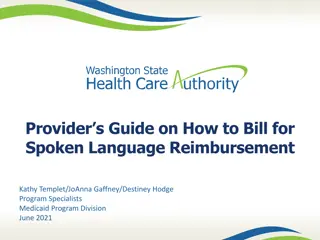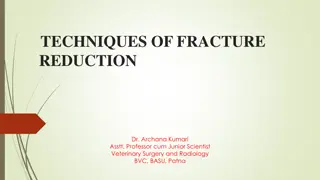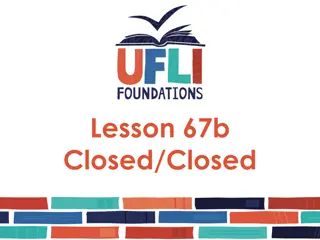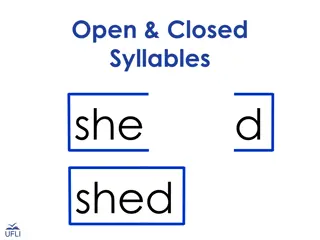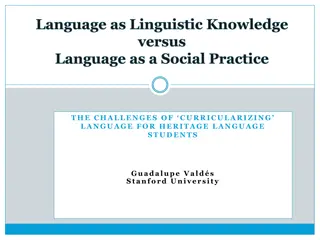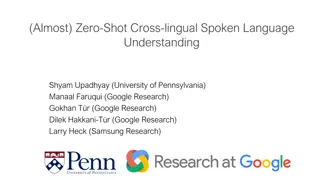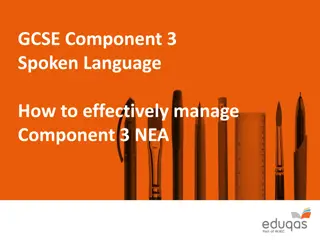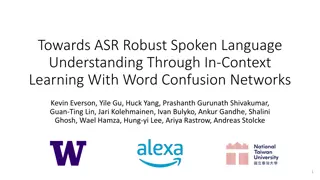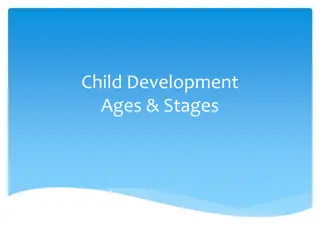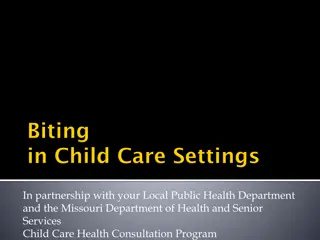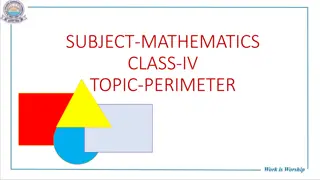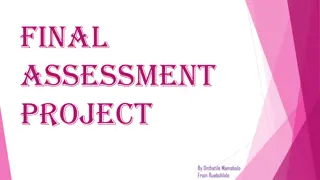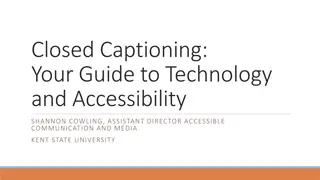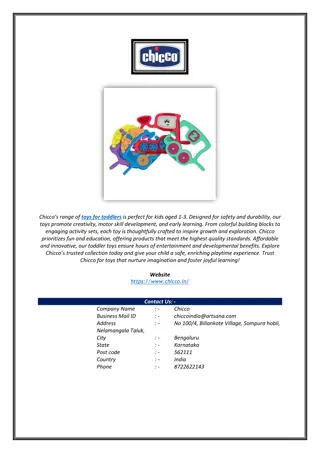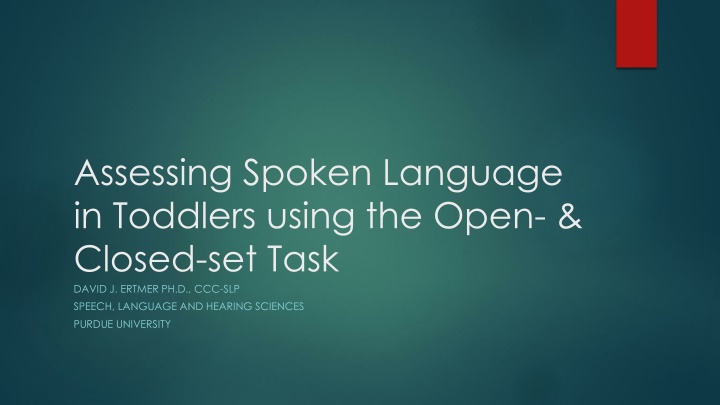
Assessing Spoken Language in Toddlers Using the Open- & Closed-set Task
Assessing spoken language abilities in very young children can be challenging due to difficulties in attending, following directions, and limited vocabularies. Production and perception ambiguity further complicates evaluation. Strategies such as play-like imitation and using familiar words can help overcome these challenges in assessing toddlers' language skills.
Download Presentation

Please find below an Image/Link to download the presentation.
The content on the website is provided AS IS for your information and personal use only. It may not be sold, licensed, or shared on other websites without obtaining consent from the author. If you encounter any issues during the download, it is possible that the publisher has removed the file from their server.
You are allowed to download the files provided on this website for personal or commercial use, subject to the condition that they are used lawfully. All files are the property of their respective owners.
The content on the website is provided AS IS for your information and personal use only. It may not be sold, licensed, or shared on other websites without obtaining consent from the author.
E N D
Presentation Transcript
Assessing Spoken Language in Toddlers using the Open- & Closed-set Task DAVID J. ERTMER PH.D., CCC-SLP SPEECH, LANGUAGE AND HEARING SCIENCES PURDUE UNIVERSITY
Remembering the not so distant past Typical ages of identification of hearing loss Ages of service delivery Limited auditory access to speech at conversational intensity levels even with hearing aids Separate schools and self-contained classes Very limited outcomes in spoken language and academics
How we got here Development and advancements in Cochlear implants Digital hearing aids Widespread adoption of newborn hearing screening Tremendous growth in Services for infants and families Special preschools for children who are D/HH Growth in well-supported mainstream placements Yet, with these advancements come new challenges for service providers
Assessing spoken language abilities in very young children Challenges difficulty in attending to and following directions reluctance to participate in unfamiliar tasks, especially with unfamiliar adults relatively small receptive and expressive vocabularies word productions that do not closely approximate adult forms.
Production and perception ambiguity Two potential perception-production problems: imitated word productions can be poor matches of the adult form even though the child might have perceived the word accurately. children s productions can be acceptable matches for the adult form but the meaning of the word might not be understood by the child.
Strategies to overcome challenges 1. The O&C uses play-like imitation and pointing activities 2. Familiar persons engage the child in the activities by using their knowledge of the individual child to facilitate participation. 3. Models are demonstrated several times through adult role-play before the child is asked to respond. 4. Early-acquired vocabulary words are used as stimuli. Familiar words also increase the likelihood imitative and pointing responses.
Strategies (Cont) 5. Photographs of objects represent each stimulus word because they are less ambiguous than line drawings. 6. Tangible reinforcement can be provided during demonstrations and following child responses. 7. Stimulus words can be repeated once during word elicitation and once during word comprehension for each stimulus item. 8. Children are asked to imitate and to identify photos of spoken words so that phonological abilities and auditory comprehension are evaluated independently.
The O&C Task (Ertmer, 2015) Criterion-referenced task to document within-child changes in spoken language ability during the first 2 years of device use Three lists of 10 words for children to imitate and then identify from three photos All target words are produced by 75% of TD 2 year-olds (Dale & Fenson, 1996) Each list is given only once; at 6, 12, or 18 months post-fitting The word lists are balanced for phonological development and number of syllables, and can be given in any order The child Hears the word Repeats the word Points to the photo of the word
O&C subtests and scores Phoneme Accuracy Measure of child s ability to imitate vowels and consonants Word Acceptability Measure of the intelligibility of child s word productions Word Comprehension Measure of understanding of early-emerging vocabulary words
Photo choices for Word Comprehension: Boat
Development of the O&C Research questions (a) Do the three O&C word lists yield comparable scores? (b) Do young children who are D/HH show improvements in O&C scores across time?
Methods for question about the equivalency of the three O&C lists The three O&C lists are given to 12 children who use CIs or HAs Attend oral education programs No additional disabilities Lists presented in balanced order across children
Table 1. Comparisons of the three O&C word lists. Question 1: Are lists comparable? List 1 vs List 2 List 1 vs List 3 List 2 vs List 3 Phoneme Accuracy (Mean Percent of points earned) 66.58% vs 66.08% t (11) = .74, p = .470 66.58% vs 63.58% t (11) = .434, p = .331 66.08% vs 63.58% t (11) = .366 p = 0.358 Word Acceptability (Percent of points earned) 80% vs 73.33% t (11) = 0.813, p = .212 80% vs 75% t (11) = .602, p = .276 73.33% vs 75% t (11) = .188, p = .426 Word Comprehension (Mean number of points earned; Maximum = 20) 17.25 vs16.25 t (11) = 0.577, p = .284 17.25 vs 15.66 t (11) = 0.856, p = .2 16.25 vs 15.666 t (11) = .321, p = .375
Methods for question about increasing scores across time 17 children with CIs Mean age at implant = 21.6 months One O&C list given at 12, 18, and 24 months post CI activation Order of O&C lists varied across children No additional disabilities Oral education programs
Figure 2. Mean percent correct for consonants and vowels. Question 2: Do children show increases across time?
Inter-tester reliability The following correlations were determined between the original and the second sets of scores: Phoneme Accuracy, r (9) = .887, p = 0.001; Word Acceptability, r (9) = .625, p = 0.5; Word Comprehension, r (9) = .625, p = 0.05.
Support for the Validity of the O&C Ambrose, Unflat Berry, Walker, Harrison, Oleson, and Moeller (2014) examined speech sound production in 37 children who were hard of hearing (HH group) and in typically developing peers who were matched for age- and socio-economic status (TD group). A single list of O&C words was given when the participants were two years-old. Transcriptions of O&C words were then used to calculate five phonological measures including Percent of Vowels Correct-Revised and Percent of Consonants Correct-Revised (Shriberg, 1993; Shriberg, Austin, Lewis, McSweeny, & Wilson, 1997). For the HH group, vowel and consonant measures obtained at 2 years- old were significantly correlated with standard scores on the Goldman- Fristoe Test of Articulation at three years of age (Goldman & Fristoe, 2000). Conclusion: O&C data were useful in predicting later phonological abilities in very young children who had mild-severe hearing losses.
Further support for validity of O&C Moeller, Bass-Ringdahl, Ambrose, VanDam, and Tomblin (2011) sought to determine whether the O&C could discriminate between children who were Hard of Hearing (HH) and age-peers with NH. The children were between 26 and 29 months-old at the time of testing. The results revealed that the HH group scored significantly lower than the NH group on Phoneme Accuracy and Word Acceptability. The HH group scores were relatively lower than TD scores on Word Comprehension task, but the difference did not reach significance. The authors concluded that the O&C was sensitive to differences in speech production between HH and NH groups and that it was helpful to compare perception and production on the same words.
Validity of Word Comprehension scores McCreery, Walker, Spratford, Oleson, Bentler, Holte, & Roushin, (2015) included O&C Word Comprehension scores in an analysis to find factors that could predict auditory and spoken language abilities 119 children who were HH. Conclusions the O&C had a high rate of completion among participants (88%) the wide range of scores on the Word Comprehension task was useful in differentiating speech recognition abilities in two year- old HH children.
Summary Newborn Hearing Screening and advances in hearing technologies have provided unique opportunities for listening and spoken language development from a very young age. The O&C fills a need for objective, age-appropriate assessment tools for toddlers who are D/HH The information provided by the O&C helps to reveal how well individual children are making gains in speech perception, speech production, and oral vocabulary during the first 2 years of cochlear implant or hearing aid use.
References Ambrose, S. E., Unflat Berry, L. M., Walker, E. A., Harrison, M., Oleson, J. & Moeller, M. P. (2014). Speech sound production in 2-year-olds who are hard of hearing. American Journal of Speech Language Pathology, 23, 91-104.. Dale, P. S. & Fenson, L. (1996). Lexical development norms for young children. Behavioral Research Methods, Instruments, and Computers, 28, 125-127. Goldman, R. Fristoe, M. (2000). Goldman-Fristoe Test of Articulation 2. Circle Pines, MN: AGS. McCreery, R.M., Walker, E., Spratford, M., Oleson, J., Bentler, R., Holte, L., & Roush, P. (2015). Speech Recognition and Parent-ratings from Auditory Development Questionnaires in Children who are Hard of Hearing. Ear and Hearing.36, 60S-75S Moeller, M.P., Bass-Ringdahl, S., Ambrose, S.E., VanDam, M., & Tomblin, J.B. (2011). Understanding communication outcomes: New tools and insights. In R. C. Seewald & J. M. Bamford (Eds.), A sound foundation through early amplification: Proceedings of the 2010 international conference (pp. 245-260). Phonak AG Immediate Proceedings Ltd., Stafa, Switzerland. Shriberg, L. D. (1993). Four new speech and prosody-voice measures for genetics research and other studies in developmental phonological disorders. Journal of Speech and Hearing Research, 36, 105 140. Shriberg, L. D. Austin, D. Lewis, B. A. McSweeny, J. L. Wilson, D. L. (1997). The percentage of consonants correct (PCC) metric: Extensions and reliability data. Journal of Speech, Language, and Hearing Research, 40, 708 722. .



